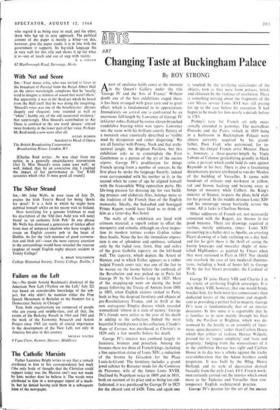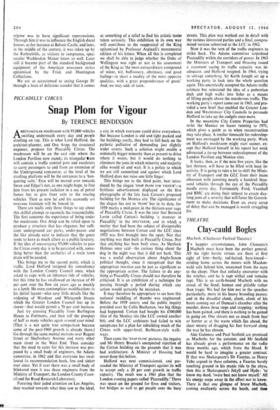Changing Taste at Buckingham Palace
By ROY STRONG
ARIOT of opulence holds court at the moment in the Queen's Gallery under the title 'George IV and the Arts of France.' Without doubt one of the best exhibitions staged there, it has been arranged with great care and to great effect, which is fundamental to its appreciation. Immediately on arrival one is confronted by an enormous full-length by Lawrence of George IV in Garter robes, flanked by votive eleven-branched candelabra bearing white wax tapers. Lawrence sets the scene with his brilliant courtly flattery of a monarch once caustically described as 'visibly used by dissipation and rather disgusting.' We are all familiar with Prinny, Nash and that archi- tectural jungle, the Brighton Pavilion, but this exhibition asks us to contemplate the First Gentleman as a patron of the art of the ancien regime. George IV's predilection for things French sprang from a number of sources. In the first place he spoke the language fluently, indeed even corresponded with his mother in it; in the second when he came of age he aligned himself with the francophile Whig opposition party. His life-long passion for dressing up, for vast build- ing projects and elaborate fetes, belongs more to the tradition of the French than of the English monarchy. Ideally, the bedaubed and bewigged Prince Regent would have liked us to think of him as a latter-day Roi Soleil.
The walls of the exhibition are lined with crimson material, a superb colour to offset the marquetry and ormolu, although on close inspec- tion its modern texture evokes G-plan rather than boulle. None the less the immediate impres- sion is one of splendour and opulence, softened only by the faded rose, fawn, blue and ochre of the great Gobelin tapestry on the left-hand wall. The tapestry, which depicts the Arrest of Haman, and in which Esther appears as a rather insipid French court tart, was one of the last to be woven on the looms before the outbreak of
the Revolution and was picked up in Paris for George IV by Sir Charles Long in 1825. Most of the snapping-up went on during the brief peace following the Treaty of Amiens from 1801 to 1803, when English visitors rushed to Paris, both to buy the despised furniture and objects of pre-Revolutionary France, and to thrill at the new outrageous Empire dresses which revealed womankind 'almost in a state of nature.' George
IV's friends were active to the year of his death in adding to the collection. Indeed the most beautiful French picture in his collection, Claude's Rape of Europa, was purchased at Christie's in 1829 only a few months before his death.
George IV's interest was confined largely to furniture, bronzes and porcelain. Among the bronzes there are three of French kings, including a fine equestrian statue of Louis XIV, a reduction of the bronze by Girardon for the Place Louis-le-Grand. The furniture includes a grand jewel cabinet by Reisener made for the Comtesse de Provence, wife of the future Louis XVIII.
Declined by Napoleon twice in 1809 and in 1811, both on account of its price and as being too old- fashioned, it was purchased by George IV in 1825 for the absurd sum of £420. Time and again one is touched by the terrifying vicissitudes of the objects, torn as they were from palaces, hOtels
and châteaux by the violence of revolution. There
is something moving about the fragments of the vast Sevres service Louis XVI was still paying
for up to the year before his execution. It had begun to be made for him nearly a decade before in 1783.
Prinny's taste for French art only occa- sionally extended to paintings. The marvellous
Poussins and the Paters (which in 1819 hung in a bathroom in Buckingham Palace) were almost certainly acquired by his grand- father, Poor Fred, who patronised, for in- stance, the emigre French artist Mercier. There is, however, a three-quarter-length by Vigee Lebrun of Calonne gesticulating grandly in black satin, a portrait which could hold its own against Reynolds at his best. There is also a fascinating documentary picture attributed to van der Meulen of the building of Versailles. It teems with hundreds of artisans and workmen in yellow, red and brown, hacking and heaving away at lumps of masonry while Colbert, the King's minister of finance, inspects the plans held aloft for his perusal. In the middle distance Louis XIV and his entourage sweep hectically across the scene. All it lacks is Charlton Heston.
Other oddments of French art, not necessarily connected with the Regent, are thrown in for good measure. There are drawings acquired at various, mostly unknown, times: Louis XIV pirouetting in a ballet skirt as Apollo; an arresting Picart drawing of a lady reclining on a day bed; and for les girls there is the thrill of seeing the knotty kneecaps and muscular thighs of mini- kilted Highlanders as painted by Finart when they were stationed in Paris in 1815. Nor should one overlook the case of late medieval illumina- tions, including a book of hours left to George IV by the last Stuart pretender, the Cardinal of York.
George IV joins Henry VIII and Charles I in the trinity of art-loving English sovereigns. It is with Henry VIII, however, that one would firmly bracket him, for both were less connoisseurs than dedicated lovers of the sumptuous and magnifi- cent as providing a perfect foil to majesty. George IV's taste is fundamentally that of an interior decorator. In this sense it is regrettable that he is familiar to us now mainly through his final folly, the Pavilion at Brighton, which was de- nounced by the hostile as an assembly of 'enor- mous squat decanters,' rather than Carlton House which that arbiter of fashion, Horace Walpole, praised for its 'august simplicity' and 'taste and propriety.' Judging from the watercolours of it in the exhibition Horace was right and Carlton House in its day was a rebuke against the trashy over-elaboration that the Adam brothers could perpetrate. It was built by the Whig, Henry Holland, and its style of decoration derived basically from the style Louis XV I. French work- men certainly carried out the interior which owed more to the Tuileries and Versailles than con- temporary English architectural practice.
George IV's passion for the art of the ancien
regime was to have significant repercussions. Through him it was to influence the English ducal houses, as for instance at Belvoir Castle, and later, in the middle of the century, it was taken up by the Rothschilds, as visitors to sumptuous, spec- tacular Waddesdon Manor know so well. Later still it became part of the standard background equipment of the American nouveaux riches epitomised by the Frick and Huntington Collections.
We are so accustomed to seeing George IV through a haze of delicious scandal that it comes as something of a relief to find his artistic tastes taken seriously. This exhibition in its own way will contribute to the reappraisal of the King epitomised by Professor Aspinall's monumental edition of his letters; When all this is completed we shall be able to judge whether the Duke of Wellington was right or not in his assessment of the King as 'the most extraordinary compound of talent, wit, buffoonery, obstinacy, and good feeling—in short a medley of the most opposite qualities, with a great preponderance of good.' And, we may add, of taste.































 Previous page
Previous page